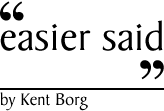|
Location,
Location, Location
This
series of columns will talk about many
various things, but will have a common
thread that is close to my heart: creating
better user interfaces. Something that is
often easier said than done.
|

|
So
diving right in, how about a complaint about the
web? Easy target? Sure, but this is the first
column!
It
is far too easy to get lost in the world wide web.
Sometimes the reaction to this is to put up site
maps to explain how to get to things, other times
to wish for (or design) better search engines or
bookmark facilities. But those approaches mostly
miss the point.
To
see the point, let's consider a little bit of the
real world. The other day I walked through a
library I had never been to before. No, not some
"virtual library", but a (mostly) old fashioned,
used-to-have-a-card-catalogue library. It was of a
manageable size and really quite nice. I took a
quick spin through all the various public rooms,
saw some interesting things, paused a couple of
times, backtracked once, and was out of there
pretty quickly. I had other places to be. I had
gone in on a whim in the first place--a bit the way
I visit most web sites.
I
didn't look at a map of the library, I didn't use
any search engines, and I didn't leave behind any
bookmarks (would I trail bread crumbs?) But if I
were to go to that same library again tomorrow I
would be able to find things I had seen before,
things I didn't know I would ever want to find
again. And so would anyone else who had been there.
This is something we take for granted.
In
contrast, when I visit many web sites, life is
seldom so simple. I am constantly thinking I should
leave various pages open in different windows so I
won't lose them. I consider leaving browser
bookmarks and I frequently read the cryptic URLs
and try to make a mental note of them.
Navigating
in the physical real world is seldom much of a
concern, but navigating in cyberspace is:
Why?
Certainly
there are differences that make cyberspace more
difficult, the key difference being that the very
flexibility of cyberspace can make it disorienting.
Cyberspace usually lacks something terribly
important.
Location.
Physical
things in the physical world have locations. There
are disadvantages to this: a physical thing can
only be in one location at a time, it takes time to
move from one location to another, etc. Oh bother!
In
cyberspace something can be in multiple locations
at once, it can change locations at a moment's
notice, and usually has no clear location at all!
Isn't that COOL!?
Well,
yes, it makes for valuable flexibility, but it also
presents problems. Physical things might be dowdy
and boring, but that can be very reassuring. If I
set down my coffee I can later reach for it and be
pretty sure it is still there. Information in
cyberspace doesn't have the same constrictions.
Where physical objects are very stubborn about
having locations, information in cyberspace is
almost as stubborn about NOT having any clear
location. Remember, this freedom about location is
an advantage: information can be hyperlinked from
here to there and all around. But in exploiting
this advantage, stop to think what we lose. We lose
that simple clarity that exists in the physical
real world, and we get lost.
What
is the solution? We must reinvent "location" for
our cyberspace information and we should be just as
conscious about crafting a location for our
information as we are about crafting the
information itself.
A
key reason why navigating that library was so easy
was that there was a coherent scheme for
everything's location and how those locations
related to each other. This coherent scheme was not
entirely due to the cleverness of the designers of
the library, it was greatly due to the restrictions
imposed by physical reality. When you are freed of
physical constraints in things like designing web
sites, realize that you are also denied the
automatic associated benefits. Rather than
concentrating only on how to exploit the
flexibility of cyberspace, stop first to figure out
how to recover some of the "features" that were
lost when you left the physical world behind.
In
my next column I will look at some practical web
site design techniques for creating a sense
location for your information.
Kent
Borg has been worrying over user interface
design problems since the 1970s. He can be reached
at easiersaid@borg.org.
Copyright
1998 by Kent Borg
|

